Text translated by Google translate.
The Iazzi of the Murgia, the ancient shelters for sheep and goats enrich the vast chapter dry stone architecture of the Apulia.
Many centuries ago goats were the first animals to be bred on the south eastern Murgia, because they are animals capable of adapting to a poor pasture, of eating branches and shrubs, and enduring drought. Goats also easily climb very steep terrain, the rocks, low walls and trees, also to defend themselves. The goat is an animal with a hierarchical social structure, for this reason it is suitable to be led in a flock by a shepherd or a shepherd dog; in the flock the adult animals protect the puppies by preventing them, for example, from falling into cliffs. They instinctively follow the direction of the wind, a behavior that facilitates their search in cases of loss of some garments. Over the south east Murgia, in particular in the Valle d'Itria and in the territory of Martina Franca, over the centuries other breeds of animals have been selected to create excellences such as the Donkey of Martina Franca and the Murgese Horse, next to the archaic Italic breed of cattle called podolico.
But the goat / sheep breeding has continued to have a prominent place over the centuries in the agricultural-pastoral economy of the place. On the Murgia, however, it was preferred to breed goats to sheep that were unsuitable for a stony territory where they risked ruining their fleece among the bushes and brambles, although sheep breeding was not lacking, however rare.
In their service area, the Masserie della Murgia to the south-east included in addition to pastures and arable land a series of stone structures intended for stables, silos, millstones and other work environments. Among them were also the Iazzi (or Stazzi), that is, the shelters for goats / sheep. Centuries ago some Iazzi were obtained in natural caves which were enlarged with excavations and divided into various rooms. A very interesting example is the ancient Iazzo of the Masseria Mangiato of Martina Franca, an underground karst cave which is located near the beautiful church of the farm. In the XVIII the hypogeum Iazzo was abandoned and a stone iazzo was built far from the main house.
Over the centuries the Iazzi have been built more and more distant from the farms, in isolated positions, even in woods. The places on the slopes facing east were chosen so as not to be influenced by the cold north winds. Two surviving examples of this type can be admired in the territory of Martina Franca: Iazzo Basile, immersed in the thick wood and Iazzo di Pozzo Orimini. Generally in the south-eastern Murgia in the iazzi the goat stables were trulli, because this is the place in Puglia where the trullo has spread most.
The Iazzi were formed by large enclosures closed by high dry stone walls that the goats could not climb over. Those walls could not be climbed even by wolves, foxes and cattle thieves. Inside the enclosure was divided by small courtyards where pregnant goats separated from beaks. On the top of the Iazzo there were goats' shelters in the shape of small trulli, on the bottom of the fence there was the shepherd's trullo, from which he controlled the whole Iazzo. Two doors to the outside. One on top, usually connected with one of the shelters, from which the goats in the morning went out to go to pasture. The other door was at the bottom of the Iazzo near the shepherd's trullo, from which the goats returned in the enclosure in the evening.
Here, sitting on a boulder, the shepherd counted the goats and then milked them one by one. Adjacent to the shepherd's trullo there was usually another trullo in which the milk was transformed into ricotta and cheeses to be aged. Inside the trullo the fireplace was also used to smoke some types of cheese. The beams incorporated into the walls were used to hang the cheese to be aged.
Goat milk has always been precious since ancient times, because it was substituted for mother's milk if necessary. It is still recommended in some diets today because it is less fat than vaccine and more digestible for lactose intolerant.
Since the end of the eighteenth century many Iazzi have been built closer to the farms, no longer on very steep slopes. Therefore, if you visit several farms you do not always find the characteristics described above, which are referable to the older ones certainly more interesting for architecture and functionality.















